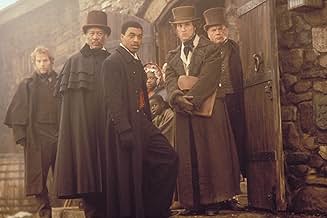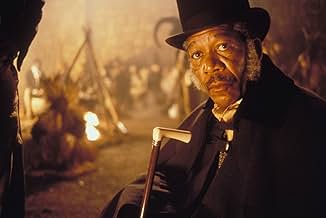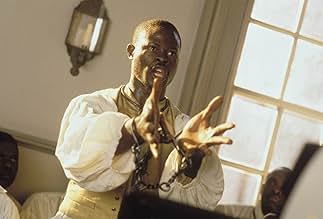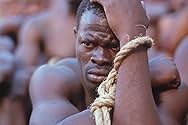In 1839, the revolt of Mende captives aboard a Spanish owned ship causes a major controversy in the United States when the ship is captured off the coast of Long Island. The courts must deci... Read allIn 1839, the revolt of Mende captives aboard a Spanish owned ship causes a major controversy in the United States when the ship is captured off the coast of Long Island. The courts must decide whether the Mende are slaves or legally free.In 1839, the revolt of Mende captives aboard a Spanish owned ship causes a major controversy in the United States when the ship is captured off the coast of Long Island. The courts must decide whether the Mende are slaves or legally free.
- Nominated for 4 Oscars
- 11 wins & 44 nominations total
- Lieutenant Meade
- (as Darren Burrows)
- Director
- Writer
- All cast & crew
- Production, box office & more at IMDbPro
Storyline
Did you know
- TriviaSir Anthony Hopkins astounded the crew by delivering the entire seven-page courtroom speech in a single take. Steven Spielberg was so in awe, he couldn't bring himself to call him Tony, and insisted on addressing him as Sir Anthony throughout the shoot.
- GoofsMartin Van Buren was never photographed while in office, and in 1839 photography was extremely new technology and not widespread. The first president to be photographed while in office was Van Buren's immediate successor William Henry Harrison in March 1841. Van Buren was photographed in 1845, well after he had left office, but he was not wearing a sash as depicted in the movie. Former Presidents John Quincy Adams and Andrew Jackson were also photographed that same year.
- Quotes
John Quincy Adams: [to the Court] This man is black. We can all see that. But can we also see as easily that which is equally true: that he is the only true hero in this room? Now, if he were white, he wouldn't be standing before this court fighting for his life. If he were white and his enslavers were British, he wouldn't be standing, so heavy the weight of the medals and honors we would bestow upon him. Songs would be written about him. The great authors of our times would fill books about him. His story would be told and retold, in our classrooms. Our children, because we would make sure of it, would know his name as well as they know Patrick Henry's. Yet, if the South is right, what are we to do with that embarrassing, annoying document, The Declaration of Independence? What of its conceits? "All men created equal," "inalienable rights," "life, liberty," and so on and so forth? What on Earth are we to do with this? I have a modest suggestion.
[tears papers in half]
- Crazy creditsThe events depicted did not historically occur at Fort El Morro
- Alternate versionsThe board of film censors of Jamaica have excised the opening scenes, depicting a violent slave uprising on a ship, from all copies of the film released in Jamaican theatres.
- SoundtracksAndante From Quartet No. 2 In B Flat Major
Written by Giovanni Battista Viotti
Performed by Quartetto Aira
Courtesy of Dynamic SRL.
That is, in essence, what Steven Spielberg's gripping drama "Amistad" is about. Through its various dramas, Spielberg presents a case about a group of Africans, who, after being seized from their home, were forced onto a ship and sent to the United States aboard "La Amistad". On their way there, the slaves, led by Cinque (Djimon Hounsou), rebelled, killing off part of the crew. However, the ship was still directed towards the United States, where the Africans were brought to trial under murder.
In the court, various factions claim ownership of the slaves, and therefore try to seize them away. The United States government, led by President Martin Van Buren (Nigel Hawthorne), and Secretary of State Secretary Forsyth (David Paymer), try to ship the Africans to Spain, where an 11 year old Isabella II (Anna Paquin) wants them back. The two Spaniards who own "La Amistad" want the slaves for themselves. The American ship that found the slaves also wants them. In the midst of this are two abolitionists (Stellan Skaarsgard and Morgan Freeman), who want the slaves to be free. They enlist the help of lawyer Matthew McConaughey, who tries to free them. Through various legal proceedings, the case appears before the Supreme Court, where it is argued by ex-President John Quincy Adams (Anthony Hopkins).
The film itself is a visual wonder. Spielberg favorite Janusz Kaminski sets the film in a dark, somber mood when appropriate, and a visual setting when appropriate as well. At times, the film is very slow, and very methodical. Spielberg is not at his finest here, the courtroom scenes have a tendency to lag. But Spielberg's finest work in the film, the opening scene, a scene of Cinque's family, and the brutal voyage of the slaves to America, is altogether stunning. It is this emotional force that carries the film. McConaughey is superb as the lawyer defending the Africans, Hopkins is sensational as the old Adams, Freeman is outstanding when used (Spielberg vastly under uses his supreme talents), and the rest of the cast is stellar. The movie, however, belongs to Hounsou. His emotional intensity is brilliant. Spielberg manages to make even the slowest scenes sparkle with focus on Hounsou, and the film's extraordinary power is simply captivating. The film is flawed, for most of the supporting characters are merely cardboard. But that doesn't matter. The story is a gripping one, and one of extreme importance. Kudos to Spielberg for finding it, finding the right men for the job, and letting the audience listen to the words of Cinque. A good job all around. ***1/2 out of 4, or an 8 out of 10.
- How long is Amistad?Powered by Alexa
Details
Box office
- Budget
- $36,000,000 (estimated)
- Gross US & Canada
- $44,229,441
- Opening weekend US & Canada
- $4,573,523
- Dec 14, 1997
- Gross worldwide
- $44,229,441
- Runtime2 hours 35 minutes
- Color
- Sound mix
- Aspect ratio
- 1.85 : 1
Contribute to this page


























